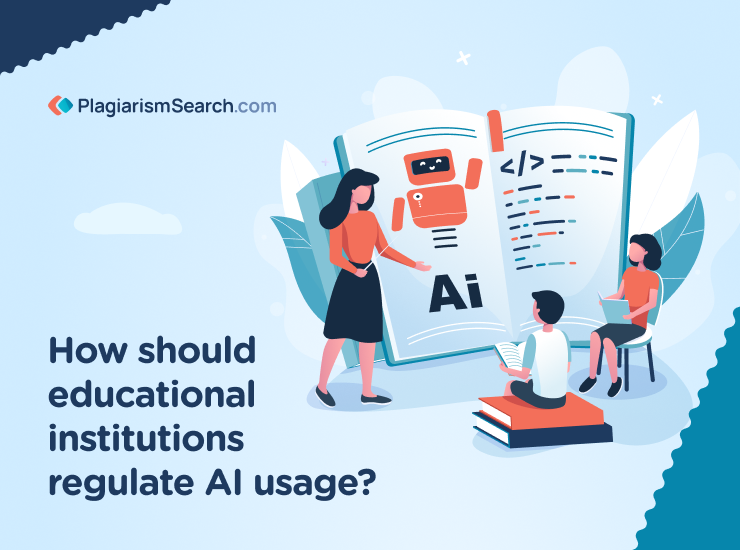
How Much Is Too Much Assistance?
Education along with all other aspects of daily life is now under the impact of a complex AI technology with multiple opportunities for improvements, but also with numerous potential challenges. It is a matter of crucial importance to regulate AI in the educational context and exclude all poor teaching practices, discriminatory strategies, biases, and misinformation. More than that, the AI learning environment should still preserve such humanistic values as ethics, responsibility, critical thinking, and cooperation. One of the initiatives of UNESCO is to create common global standards according to which the use of the latest technologies requires a human-centric vision. The steps include data privacy protection along with the requirements for AI providers for ethics of use and age limit for classrooms. Moreover, UNESCO emphasizes the need for AI validation for student use in schools and effective artificial intelligence regulation.
Use of AI in Education: Positive Aspects
The overall positive effect of AI education if introduced effectively is extensive:
- Better access: Quality education becomes more realistic with the use of AI-powered educational platforms as they eliminate the problem of limited resources or location barriers.
- Personalization of studies: It is much easier to take into account the individual student needs with the new AI algorithms as they enhance adaptation of specific learning experiences.
- Development of core skills for the future: There are more career opportunities open for the learners equipped with the knowledge of AI principles, essential for the future employment market.
- Empowerment: The realities of modern ever-changing world demand integration with the latest technologies.
Misuse of AI in Education: What Can Go Wrong without Regulation
Although the use of AI capabilities in education is extraordinarily broad, it can still be improper or unethical without specific restrictions and control over the scope of AI content. A lot of educators are deeply concerned about the harmful effects of AI technologies at school.
- Plagiarism
If AI is used as a research tool, misuse of AI in education becomes obvious. Without any citing, students easily do paraphrasing or copying of the ready-made answers and get essays and research with no effort exerted. Such plagiarism detection tools as PlagiarismSearch.com have already adapted to new conditions and now can identify the likelihood of using AI in generating content, but unfortunately it is still not possible to specify the percentage exactly. At the same time, using the plagiarism detection software with AI authorship is a mandatory measure taken to maintain the principles of academic integrity.
- Artwork generated by AI
There is an increasing amount of AI-generated images and video content online. It is quite possible that students do not develop their own creativity, but simply use the power of artificial intelligence to submit to their professors.
- Translation
Language understanding skills of the students will not develop if they opt for inaccurate artificial translation to save their time and effort. Besides, some of the ideas may be misinterpreted.
- Mathematical calculations
Learners fall out of practice if they rely on the computational abilities of AI only. They do not acquire proper knowledge of the formulas or principles of problem solving.
- Programming
Instead of learning, practicing, and developing new coding solutions, students generate codes with the use of AI and lose their chance for an impressive future in the sphere of IT.
AI Policy for Schools: Aspects to Consider
Introducing AI education properly into the teaching and learning process requires careful studying of the students’ challenges and needs. There are a number of aspects to take into consideration both at the level of a certain school and globally:
- Access to technologies: AI-powered tools in educational systems can be effective only in case of good access of teachers and students to laptops, tablets, and other devices along with ensuring perfect internet connection in classes.
- Integration of AI tools into the curriculum: All current standards and objectives of learning should be aligned with the new AI technologies.
- Training teachers: Teachers should be equipped with proper knowledge and skills to ensure responsible use of AI and help students navigate the platforms and use AI tools.
- Involving parents: The entire community should be engaged to enable collaboration in the learning environment of a new type.
- Cultural sensitivity: Relevance of the AI-generated content should be double checked to make sure that it reflects the cultural experience and background of all learners without any bias or prejudice.
Ways of AI Regulation at Schools
Forbes indicates that there is a “worrying lack of public scrutiny” over the use of artificial intelligence at schools and formal guidance is insufficient in education. Thus, there is a major concern over the impact of AI on the mental health of the students as well as on potential cheating in all courses with a counterbalance of potential positive effect of AI on the quality of education.
Schools are supposed to address the daunting topic of using AI at schools and make use of the following solutions:
- Professional development and certified training for teachers to manage the technical issues;
- Enhancement of the skills in operations and security of IT school teams;
- Setting an age limit of 13 for the classroom use of AI tools;
- Introducing transparent AI procedures and algorithms.
Regulation is of paramount importance in terms of the future of AI use in education. With the focus on fair and ethical usage, it is a must to develop ethical regulatory frameworks that will cover such topics as originality, accountability, biases, privacy, and transparency. There should be a balance between the innovation and keeping traditions with the priority given to social values and efficiency. Artificial intelligence has come to stay, and it is time to develop the strategies which will both improve the productivity and ensure the ethical nature of teaching and learning.
